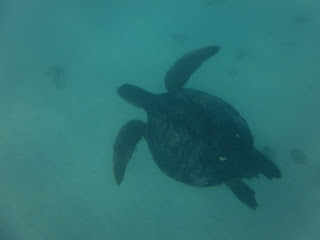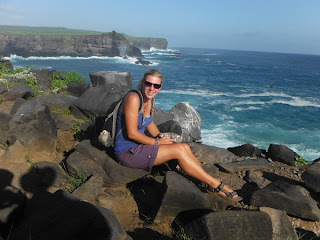Most of us arrived in Quito knowing one thing, that we were off to explore the Galapogos Islands. The Galapogos cruise had been booked since before we left the UK so 16 of us, very excited flew out the 3 hours to Baltra island to start our 4 night cruise.
The Galapogos Islands were made famous by Charles Darwin in 1831 when he visited the islands, looked at all the plants and animals and then wrote all his books on evolution. The islands are a UNESCO site and the Galapogos National Park protects 97% of the land with the other 3% being areas where people live.
We visited 6 islands and all were different in what they looked like and also what animal species they had living there as some species are endemic to certain islands. It was safe to say that from the moment we got to the dock to get on our boat, the very appropriately named 'Darwin' we had smiles plastered on our faces until the end of the trip as we were constantly treated to wildlife delights. Without even starting our cruise we had already seen sealions, pelicans and a swimming marine iguana!
The cruise had a busy schedule and I didn't actually realise how tiring it was going to be as we had many short walks planned and lots of snorkelling. If I'm honest, the underwater world beat the land world hands down and I could have happily had a week's worth of snorkelling. Saying that, the whole trip was great and worth every penny and the only thing I could fault was that there was far too much fish served on board. Yuk!
The wildlife was amazingly unfazed at our presence. There was a 2m distance rule applied but most things I'm sure you could have got closer to. The only thing that we saw from a big distance was the Galapogos Penguin. Even when on the boat we saw plenty as the birds followed us and one evening we had moored up so were able to watch nature's TV from the back of the boat which involved circling sharks, sealions and pelicans catching fish. Here's a list of a few things we saw and a fact if I can remember one:

Pelicans- can scoop up 2 gallons of water in a beak full and then filter the fish out.

Marine Iguanas- have adapted their tails to make them longer and flatter to aid swimming


Sally lightfoot crabs- unusually can walk sideways and forwards


Land Iguanas- we saw 2 species. One species had yellow feet and belly which it had got from eating lots of yellow flowers


Painted Locust

Lava lizards-males have the red throat.

Frigate birds- males have the red throat, females are brown and white colour

Sealions






Nazca booby

Blue footed booby- males do a dance for the females but ultimately the male with the bluest feet wins.

Lava Heron
Swallow tail gulls- the only bird to feed at night to avoid competition with frigate birds.

Mockingbirds-the male makes the nest as colourful as possible using bits of plastic collected from the ports. The female then picks the male with the most colourful nest. After eggs hatch the female leaves and then the male is left to look after the chicks.
Galapogos Hawk
Waved albatross

American Oyster catcher

Darwin finches
to be continued....



















































